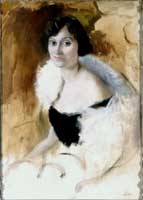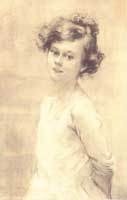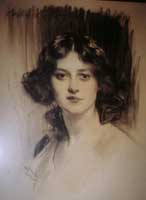|
(Elizabeth Bibesco, nee Asquith) Augustus John -- British painter (1878-1961) 1924 Sutton Place Oil 40 X 30 in. jpg: paul darby Princess Elizabeth Bibesco (nee Asquith) (February 26, 1897 - April 1945) was a writer and the daughter of the Prime minister of Great Britain Herbert Henry Asquith (from 1908-1916) and second wife Margot Asquith. In 1919 she married Prince Antoine Bibesco (1878-1951), the Rumanian envoy in London and they would have one daughter. They lived primarily in Paris. Paul Darby tells me that she was an amazing woman.
 Elizabeth Asquith 1919 Elinor M. Barnard  Elizabeth Asquith (Bibesco) 1907 John Singer Sargent  Elizabeth Asquith 1914 From: Paul Darby
(. . . ) I don't have a really good closeup of the Augustus John painting but was able to get a fuzzy image from my little 20 dollar camera [above]. The picture was very famous in its day. It was bought by a man from Buffalo in 1926 and then resold to John Paul Getty in 1938. He hung it in a guest bedroom at Sutton Place, his mansion in England but it has since moved on . . . ( . . .) This has been quite the week for my continuing "conjunction" with Elizabeth Bibesco. At the start of it I ordered a book by her from abebooks.com and discovered that the book dealer's godmother was (is) Priscilla Bibesco (Elizabeth's only child). There followed a number of interesting conversations with him. Then I discovered another book dealer selling a hand written note (of no great import) from Elizabeth. I chose NOT to buy it but it is the first letter of hers that I have seen on offer. Then I found your website. Later in the week I blundered into www.wikipedia.com (a free encyclopedia) and have placed a short biography with picture there (under "Elizabeth Bibesco"). I also did a short bio of her husband ("Antoine Bibesco"). Over the years I have gathered enough material on this woman to bring her half alive. From year to year I find more tit-bits. From:
www.wikipedia.com
Elizabeth (Asquith) Bibesco . . . was an English writer, active between 1920 - 1940. A posthumous collection of her stories, poems and aphorisms was published under the title "Haven" in 1951, with a preface by Elizabeth Bowen. . . .Elizabeth was a precocious child, able to sing 28 songs with all their words in perfect tune before she was two years old. It is said that she and her brother would throw things from the third floor windows at the suffragettes shackled to the railings below. Life at 10 Downing Street thrust her into the public eye at an early age and she developed a quick wit and a social presence beyond her years. When she was just 14 years old The Times of London (reporting on her recovery from pneumonia) stated that "many members of the House have made the acquaintance of Miss Asquith and in expressing their concern for her health, have referred to her charm of manner and to the interest which she has begun already to show in political matters." During World War I she was given many opportunities to do "good works", often organizing and performing in matinees for the soldiers. Her first known literary effort was a short duologue called "Off and On" which she performed with Nelson Keys in 1916 at the Palace Theatre. In 1916 she also organized a large showing of portraits by John Singer Sargent at the Grafton Galleries to aid the Art Fund and organized a "Poets' Reading" in aid of the Star and Garter Fund. In 1919 she married Prince Antoine Bibesco (1878-1951), the Rumanian envoy in London, a man twenty-two years her senior. She gave birth to her only child, Priscilla, the next year. They resided at the Bibesco townhouse on the Quai Bourbon in Paris, situated on the Seine with a view including Notre Dame cathedral. The walls of the house were decorated with huge canvases by Vuillard. Prince Bibesco was a life-long friend of Marcel Proust and after his marriage to Elizabeth she too became a favorite of the reclusive writer. At the time of her marrige he wrote that she "was probably unsurpassed in intelligence by any of her contemporaries," and added that "she looked like a lovely figure in an Italian fresco". He would leave his house late at night to visit them, to discuss Shakespeare with Elizabeth or gossip with Antoine until dawn. Elizabeth wrote a moving obituary for Proust in November 1922 in the New Statesman. "Gently, deliberately, he drew me into that magic circle of his personality with the ultimate sureness of a look that needs no touch to seal it. Insensibly you were drawn into that intricate cobweb of iridescent steel, his mind, which, interlacing with yours, spread patterns of light and shade over your most intimate thoughts." Her husband fostered Elizabeth's literary development. She wrote three collections of short stories, four novels, two plays and a book of poetry. All of these works have a "continental" sensibility. They deal almost entirely with a kind of love in which the heroines ponder the least gesture of a man until it takes on the proportions of an emotional event with lasting implications, while the heroes spend their time in mute surrender at the feet of remote and disdainful women. "One young poet had described her soul as a fluttering, desperate bird, beating its wings on the bars of her marvellous loveliness," is a sample of her prose style ("Pilgrimage", 1921). Her stories, which by 1940 were considered merely fashionable, flimsy stuff with no lasting significance, can now be seen as the illumination of a class of people who were made irrelevant by the First World War but who refused to accept their irrelevance. Elizabeth Bibesco was connected (especially in the mind of the media) with Virginia Woolf and Katharine Mansfield, neither of whom treated her well in their letters, especially after a liaison between Elizabeth and Mansfield's husband, John Middleton Murry. She travelled the world with her husband in his capacity as Romanian envoy, first to Washington (1920-1926) and then to Madrid (1927-1931). She was in Romania during World War II, and died there in 1945 at the age of 48. Her death was the final sorrow for her mother who died within months of her daughter's passing. Elizabeth's portrait was
painted
twice by Augustus John, in 1919 and again in 1924. The first (titled
"Elizabeth
Asquith") shows her as a vivacious debutante in a fur or feather stole
over bare shoulders. An illustration of this picture can be found in
John's
autobiography Chiaroscuro. In the second portrait (titled "Princess
Antoine
Bibesco") Elizabeth appears slightly weary and melancholic, her eyes
averted
just enough to suggest a break in her former self-confidence. She wears
a mantilla given to her father by the Queen of Portugal and holds in
her
hand one of her own books. When shown at the Royal Academy summer show
in 1924 Mary Chamot, writing in Country Life, wrote of this painting
that
it "had the force to make every other picture in the room look insipid,
so dazzling is the contrast between the mysterious darkness of her eyes
and hair and the shimmering brilliance of the white lace she wears over
her head."
Notes Special thanks to Paul Darby, from Canada, a friend of the JSS Gallery, for sending me the image and note. |

By: Natasha
Wallace
Copyright 1998-2004 all rights
reserved
Created: 8/11/2003
Updated 5/24/2004